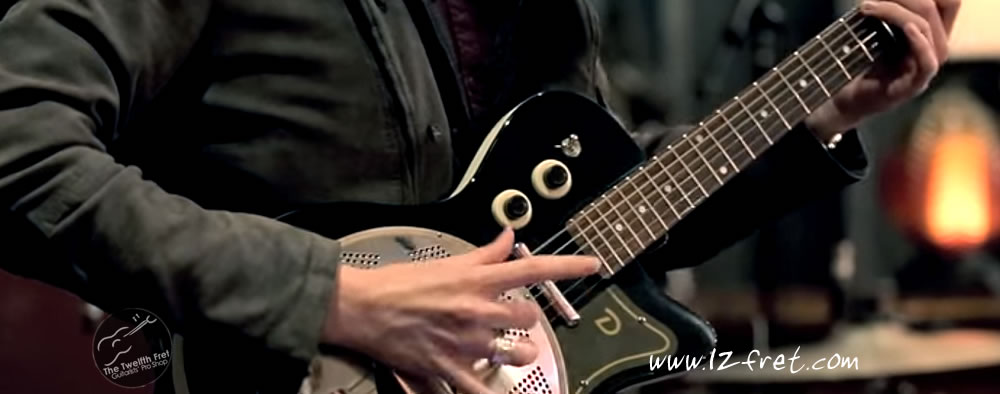
You know from the very beginning when something is called “dead thumb” it’s going to be cool!
The dead thumb technique is very old and many of the oldest blues and roots recordings feature it fully or in some variant form. People interested in older blues styles will know the sound of this technique right away, but lately a number of newer, popular artists are revisiting it with great success and bringing it to a wider audience. The artist Hozier is a great example of a young popular artist who is using this technique in a lot of his hit songs.
Here is Andrew Hozier playing “Like Real People do” watch his right hand thumb and notice how he is droning the note G as he plays a melody above.
Here is Lindsey Buckingham of Fleetwood Mac using it as the backbone of Rhiannon. Lindsey has replaced the evenly spaced bass notes with a little syncopated part to add even more variety to the tune. You can hear the guitar part very clearly before Stevie and the band come in.
Playing A Simple Dead Thumb Blues – How Do We Do This?
The “Dead Thumb” technique is actually pretty simple and straight forward in one sense. With the thumb of your right hand you play evenly spaced based notes usually on the down beats and usually on the root notes of whatever chord you want to play. So if you are in E (a good choice for a dead thumb tune) and in 4/4 time you will play the note E on the beats 1,2,3,4, a pretty simple thing to do. Whenever you hear this kind of repeated bass line on a guitar you are hearing the dead thumb technique.
In the video above Andrew Hozier is playing in G so he is droning the note G, he is also playing in 3/4 time which is a bit harder for most people to feel than 4/4. I’m going to use E because it’s an open string and a bit easier to use when getting used to this style and I’m going to use 4/4 time as it’s easier for most people than 3/4.
Some people like to present the dead thumb technique as a simplified variation of the Travis style which incorporates an alternating bass line of usually two notes but possibly more, which is in a way true. You can think of the dead thumb technique as Travis picking with only one bass note and no alternating. I usually try to present it to my students as its own thing as opposed to a variation of the “Travis” style but it’s really a six of one and a half dozen of the other kind of thing.
I said above that the technique is pretty simple in one sense, and of course it is, but it’s also hard to get down at first. I always introduce this technique to students by pointing out it’s like tapping your head and rubbing your belly at the same time. Each of those things is dead simple on their own but together they become much harder. The dead thumb technique is exactly the same. Those four evenly spaced bass notes become pretty hard when a second different melody is added above.
So let’s start a little blues doing this. A standard 12 bar blues in E generally begins with four bars of E followed by two bars of A followed by two bars of E followed by one bar of B then one bar of A then two bars of E which usually incorporates a turnaround. A turnaround is anything that makes a smooth transition back to the top so the 12 bars can be played again.
So a 12 bar blues in E is going to have 11 bars of either E or A which we can play on open strings. So for most of our dead thumb introduction will not have to worry about fretting bass notes.
Here is the 12 bar dead thumb bass part by itself.
You could probably get a student to play this on their very first guitar lesson, it’s that easy. Let’s add a little blues call and answer lick to that. The first part of course is the call and the second is the answer I’m going to play the same thing twice to keep it simple.
This is a bit harder than the bass line but still fairly simple to play. Now let’s play them at the same time. This is one of those moments where putting two dead simple things together sounds like a million bucks. Here they are to together.
This is where things usually start to get tricky. I always make the distinction between what I think is tricky and what I think is hard. This isn’t hard to play by any stretch but it is tricky so go slow and count if you have to. You will most likely find that you keep modifying one of the parts to make it rhythmically the same as the other when you first try to put these things together. The goal here is to keep both parts rhythmically distinct so they sound like two people to a listener.
I’m going to add a similar thing to the A chord now keeping it very simple. Since the A chord has a C# in it I’m going to change the note D from my first lick to a C# but keep everything else the same. This is done to acknowledge that as the soloist you are aware that there has been a chord change.
I won’t break down the entire rest of the song by bar but will play it through slowly to demonstrate how this applies to the whole tune. I’m also going to replace the last two bars of this 12 bar with a simple turnaround that most people will recognize as something they have heard a million times before. So here it is all together.
Playing A Simple Dead Thumb Blues and the the dead thumb technique is a great way to spice up your playing and can be a nice departure from strumming songs that are starting to get a bit monotonous. You can hear this technique and variations of it in a lot of Hozier’s songs, The Lumineers, Mumford and sons Fleetwood Mac Robert Johnson and many others.
The ultimate goal of this technique is to get yourself to a place where you can improvise melodies and solos over the bass lines.
~ Dave Martin – The Twelfth Fret Music School
